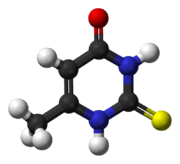Methylthiouracil
 | |
 | |
| Clinical data | |
|---|---|
| AHFS/Drugs.com | International Drug Names |
| ATC code | H03BA01 (WHO) |
| Identifiers | |
| |
| CAS Number | 56-04-2 |
| PubChem (CID) | 667493 |
| ChemSpider | 580871 |
| UNII |
QW24888U5F |
| KEGG |
C19265 |
| ChEMBL | CHEMBL1330588 |
| ECHA InfoCard | 100.000.230 |
| Chemical and physical data | |
| Formula | C5H6N2OS |
| Molar mass | 142.18 g/mol |
| 3D model (Jmol) | Interactive image |
| |
| |
| (verify) | |
Methylthiouracil is an antithyroid preparation. It is a thioamide, closely related to propylthiouracil.
Methylthiouracil is not used clinically in the United States, it has a similar mechanism of action and side effect to that of propylthiouricil.
The drug acts to decrease the formation of stored thyroid hormone, as thyroglobulin in the thyroid gland.
The clinical effects of the drug to treat the hyperthyroid state can have a lag period of up to two weeks, depending on the stores of thyroglobulin and other factors.
Side effects
Agranulocytosis: develops rapidly, sore throat and fever are hallmark symptoms. Can be fatal if drug is not discontinued promptly.
Allergic skin reactions the most dangerous of which is exfoliative dermatitis, it rapidly can get out of control, notify the physician should a skin eruption occur.
Hepatitis: yellowing of the skin, nausea, yellowing of the whites of the eyes, flu-like symptoms.
Thrombocytopenia: unusual bruising or bleeding.
Synthesis

Methylthiouracil is prepared quite simply by condensation of ethyl acetoacetate with thiourea.
Further work in this series shows that better activity was obtained by incorporation of a lipophilic side chain.
References
- ↑ R. List, Justus Liebigs Ann. Chem., 236, 1 (1886).